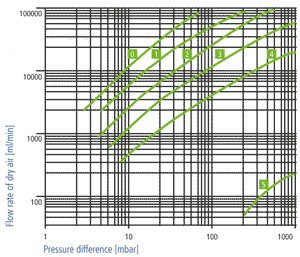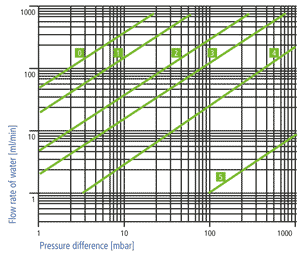Cleaning and usage instructions for glass
filter discs and glass filter apparatuses
Prime cleaning
Before using a glass filter apparatus for the first time, it should be cleaned
from all dust and dirt particles. For that you use hot hydrochloric acid, followed
by several steps of distilled water sucked through the filter disc.
Mechanical cleaning
Glass filter instruments should be cleaned immediately after use to extend
the durability. If the pores of the filter disc are clean, it is sufficient to spray the
surface with water and to clean it with a brush or a rubber wiper. If the pores
are contaminated, back-flushing with water or rinsing solution is absolutely
necessary. The pressure applied must not exceed 1 bar. After that a blowingthrough
with pure air dries and cleans the filter disc additionally.
Chemical cleaning
If there are still clogged pores after a mechanical cleaning, a careful chemical
cleaning is advisable. Depending on the contamination different solutions may
have to be used. Afterwards the filter discs should carefully be rinsed with
water.
Drying and sterilization
To prevent tensions between filter and vessel, you have to avoid temperature
shocks, which can lead to breakages in the filter apparatus. Heating and
cooling of glass filter instruments should be carried out slowly and evenly.
Pressure- and vacuum resistance
Pressure- and vacuum resistance cannot be guaranteed because of the
material. Even the smallest damage of glass surface (like scratches) causes a
loss of stability.
Temperature resistance
The maximum short-term operation temperature is 500 °C. Sudden temperature
changes of glass filter instruments should be avoided. It is necessary to care
about the designated heating and cooling rates for borosilicate glass 3.3 to
avoid permanent tension in the glass.
Special notes
An increase in pore size is unavoidable with filtration of phosphoric acid,
hydrofluoric acid and hot alkaline solutions. These solutions attack the glass
surfaces and make them unsuitable as cleaning agents. Their usage decreases
the durability of glass filter instruments considerably.
Porosity classes
Glass filters are divided into porosity classes from 0 to 5. Measurement of
the porosity is carried out by a so-called bubble point process according to
Bechthold. The following table provides an overview of porosity areas as well as
their main fields of application. The specified pore size refers to the respective
largest pore of a disc. Pore sizes mark also the minimum diameter of particles
which can just be held back during filtration.
| Porosity | ISO 4793 | Nominal pore size | Examples of application | |
|---|---|---|---|---|
|
0 |
P 250 | 160-250 µm | Gas distribution, filtration of coarse deposits, gas distribution in liquids | |
|
1 |
P 160 | 100-160 µm | Filtration of coarse deposits, gas distribution in liquids, rough gas filtration, extractors for coarse materials, mats for filterlayers against gelatinous deposits | |
|
2 |
P 100 | 40-100 µm | Preparative fine filtration, mercury filtration, preparative operations with crystalline deposits | |
|
3 |
P 40 | 13-40 µm | Analytical filtration, preparative operations with fine deposits, filtration in cellulose chemistry, refined gas filtration, extraction instruments for fine-grained materials |
|
|
4 |
P 16 | 10-16 µm | Analytical presicion filtration and operations with very fine deposits, as check and stop valve for mercury | |
|
5 |
P 1,6 | 1,0-1,6 µm | Filtration of bacteria, sterile filtration |
Influencing factors for flow rates and pressure drop
• Filter size
• Filter porosity
• Pressure/vacuum properties of the apparatus
• Physical properties of sample
To choose the proper apparatus for the intended work, it is necessary to know
the flow rates of liquids and gases. Please use the diagrams below
which show data for water and air. The data apply to filter discs of 30 mm
diameter with average properties and usually effective filter area and thickness,
as well as pore sizes. The flow rates for other diameters can easily be calculated
by multiplying this data by the conversion factor.
Air flow rate related to pressure difference (filter plate dia. 30 mm)
Water flow rate related to pressure difference (filter plate dia. 30 mm)
| Conversion factors of flow rates | |||||||||
| Filter disc diameter (mm) | 10 | 20 | 30 | 40 | 50 | 60 | 90 | 120 | 175 |
| Conversion factors | 0,13 | 0,55 | 1,00 | 1,50 | 2,50 | 4,30 | 6,80 | 9,70 | 15,00 |



